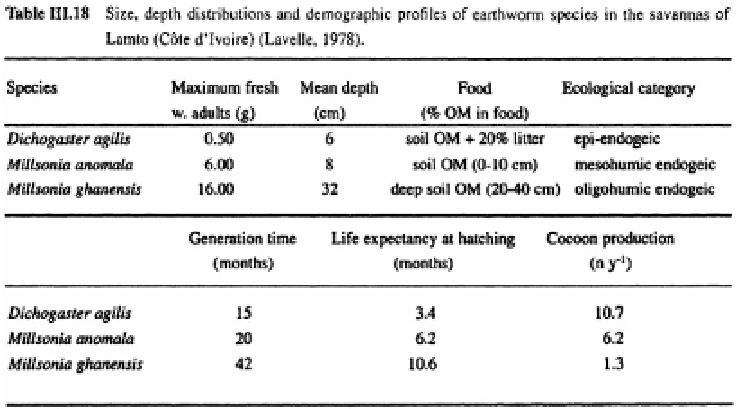Agriculture Reference
In-Depth Information
and of low energy density.
Millsonia anomala
is a mesohumic endogeic species which
exploits an intermediate part of the gradient; size, preferred depth and demographic
profiles are all intermediate between the two other species discussed above.
Further examples are found in many other groups such as Collembola whose life-forms
are directly related to depth (
e.g.,
Gisin, 1943). Among the Collembola and Acari, body
size tends to decrease with depth, in response to the smaller soil pores. However, some
groups can colonise a wider part of the environmental spectrum than others and size and
phylogenetic constraints are again the determining features. While the major groups
of macrofauna
i.e.,
earthworms and termites are able to exploit most of the gradient,
the mesofauna is generally restricted to the upper part of the gradient, with a distinction
between epi- and hemiedaphic groups. The limited size and strength of these animals
does not permit them to dig their way through the soil and they require relatively
high-quality resources to sustain their high metabolic rates. Endogeic life is limited
because movement is restricted to the larger pores and resources are highly dispersed and
partly inaccessible. Only a few animals with specific adaptations (
e.g.,
Symphyla) living
on tuberous roots or specialised root-feeding herbivores or saprophages are found.
As a result, predators of endogeic macrofauna are also scarce.
4.4.3.2
Regional scale: the effect of types of vegetation, soils and land use
on communities
Soil faunal communities clearly reflect differences in vegetation and management
practices. In temperate and tropical areas, grasslands are always more favourable for
earthworms than forest ecosystems. This is probably due to the better quality and greater
abundance of organic resources available in grasslands, and also to a more favourable
water regime since soil water losses by evapotranspiration are greater in woody than in
herbaceous vegetation. Woody vegetation favours litter and wood-feeding invertebrates.

